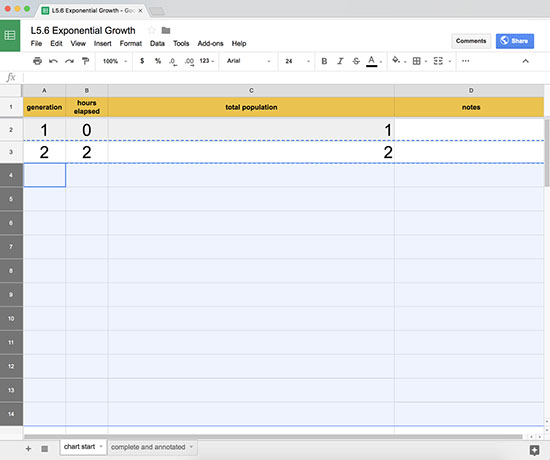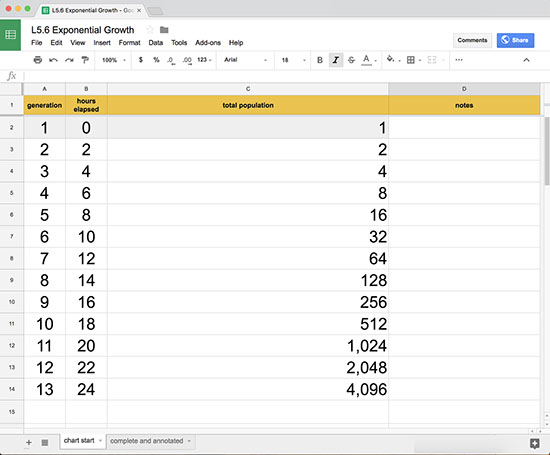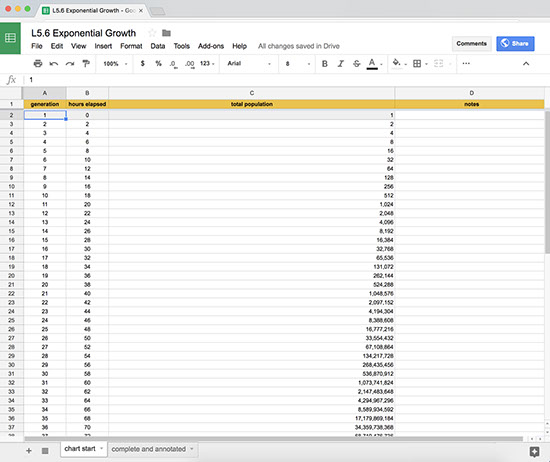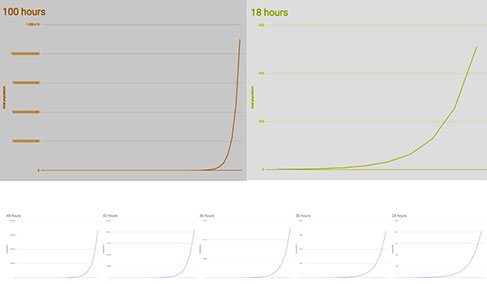SciGen Teacher Dashboard
Unit L5
The Sensational Single Cell
 Writing: Science-Fiction Science—Grey Goo
Writing: Science-Fiction Science—Grey Goo
Duration: Approximately 75 minutes
In this unit, robots have provided a model for yeast cells. In the real world, yeast cells provide a model for cancer research. What happens when a cell is damaged, stops following instructions, and consumes all the resources around it? It's not dissimilar to what we imagine would happen if robots stopped following instructions and went rogue. Students are challenged to apply what they've learned in this unit to making a case for why the world isn't covered by the grey goo of self-reproducing organisms (or robots).
LEARNING OBJECTIVE
Students will be able to justify why yeast is used as a model for cancer research.
Students will be able to explain the limitations of yeast as a model.
Students will be able to analyze and interpret a data chart of (or use mathematics and computational thinking to explain) exponential growth.
Students will be able to communicate to others (or create an argument for) why abnormal cell division is linked to cancer.
Teacher Tips
- You can add more math practice to this writing exercise by skipping the prepared class introduction on exponential growth in Google slides and sheets, and instead ask your students to create an exponential growth chart by hand in their notebooks. They could do this by doubling the values using either a pencil and paper or a calculator. Some calculators will display an error message if the result is too high.
- This activity uses a pre-made Google docs spreadsheet. If you prefer not to use it online, it can be downloaded to use in any spreadsheet program (such as Numbers or Microsoft Word).
- Review the focus words of the week. The focus word chart linked on the unit overview page should be used as a resource for students to review definitions and sample sentences.
Materials (one per student or group)
- optional: electronic device (such as computer, laptop, tablet) if looking at graphing in Google Sheets individually/in pairs rather than as a class
Teacher Tune-ups
Teaching Notes
ACTIVITY OVERVIEW
- Introduce exponential growth with numbers (20 minutes)
- Compare exponential growth in graphs (20 minutes)
- Introduce exponential growth in cancer (5 minutes)
- Read about a fictional scenario: Grey goo (10 minutes)
- Discuss and write about grey goo and other runaway growth (20 minutes)
Introduce exponential growth with numbers (20 minutes)
You can add more math practice to this writing exercise by skipping the class introduction and asking your students to create an exponential growth chart by hand in their notebooks, either by doubling the values using pencil and paper or a calculator. Some calculators will display an error message if the result is too high.
This activity uses a pre-made Google spreadsheet. Copy it to your drive to make changes. If you prefer not to use it online, it can be downloaded from that site to use in any spreadsheet program (such as Numbers or Microsoft Word).
Exponential Growth in Numbers
(steps to filling the spreadsheet)
Step 1: Select all of Row 3 and copy to the clipboard.

Step 2: Select multiple rows to fill.

Step 3: Paste contents of the clipboard into the selected rows.

Step 4: Ta-da! The rows are filled to model exponential growth.

Step 5: You can keep going to fill in more rows.

Compare exponential growth in graphs (20 minutes)
Exponential Growth in Graphs
Introduce exponential growth in cancer (5 minutes)
Read about a fictional scenario: grey goo (10 minutes)
Eric Drexler first used the term "grey goo" in his 1986 book Engines of Creation:
 Imagine such a replicator floating in a bottle of chemicals, making copies of itself…the first replicator assembles a copy in one thousand seconds, the two replicators then build two more in the next thousand seconds, the four build another four, and the eight build another eight. At the end of ten hours, there are not thirty-six new replicators, but over 68 billion. In less than a day, they would weigh a ton; in less than two days, they would outweigh the Earth; in another four hours, they would exceed the mass of the Sun and all the planets combined — if the bottle of chemicals hadn't run dry long before.
Imagine such a replicator floating in a bottle of chemicals, making copies of itself…the first replicator assembles a copy in one thousand seconds, the two replicators then build two more in the next thousand seconds, the four build another four, and the eight build another eight. At the end of ten hours, there are not thirty-six new replicators, but over 68 billion. In less than a day, they would weigh a ton; in less than two days, they would outweigh the Earth; in another four hours, they would exceed the mass of the Sun and all the planets combined — if the bottle of chemicals hadn't run dry long before.
Discuss and write about grey goo and other runaway growth (20 minutes)
When finished with the activity, ask students to discuss the question with a neighbor before writing creatively.
While wrapping up this session, make a connection between any suggestions the students had about how a fast-growing population can be stopped and next week's focus on multicellular organisms and immune response. Cancerous cells are often identified and removed by the body's immune system.
Consider this question.
celldividemultiplyfungusindividualreproductionseparateexponentialmicroscopicnucleusnutrientfuelprocessmatterOf course, it's unlikely anything like this will happen. Why not? Could yeast cells (or self-reproducing robots) go on reproducing themselves indefinitely? What, if anything, limits the total number of cells or robots that can be built?
Discuss your answers with someone else. Then write a short fictional scenario that illustrates rapid growth and then death of a large population of robots, single-celled organisms, or some other kind of machine or creature.
In your response, be sure to include:
- Why or how your fast-growing population reproduces
- What four things each individual needs to be able to do
- At least one way a fast-growing population can be stopped
- Some of the focus words
BETA Version - Please send comments and corrections to info@serpinstitute.org

